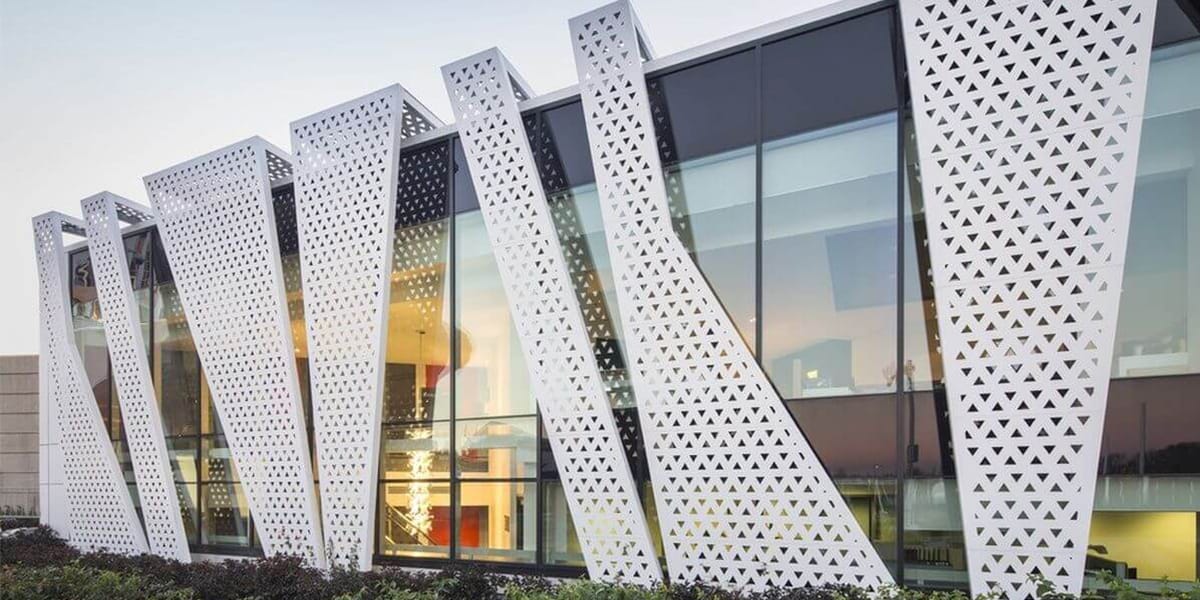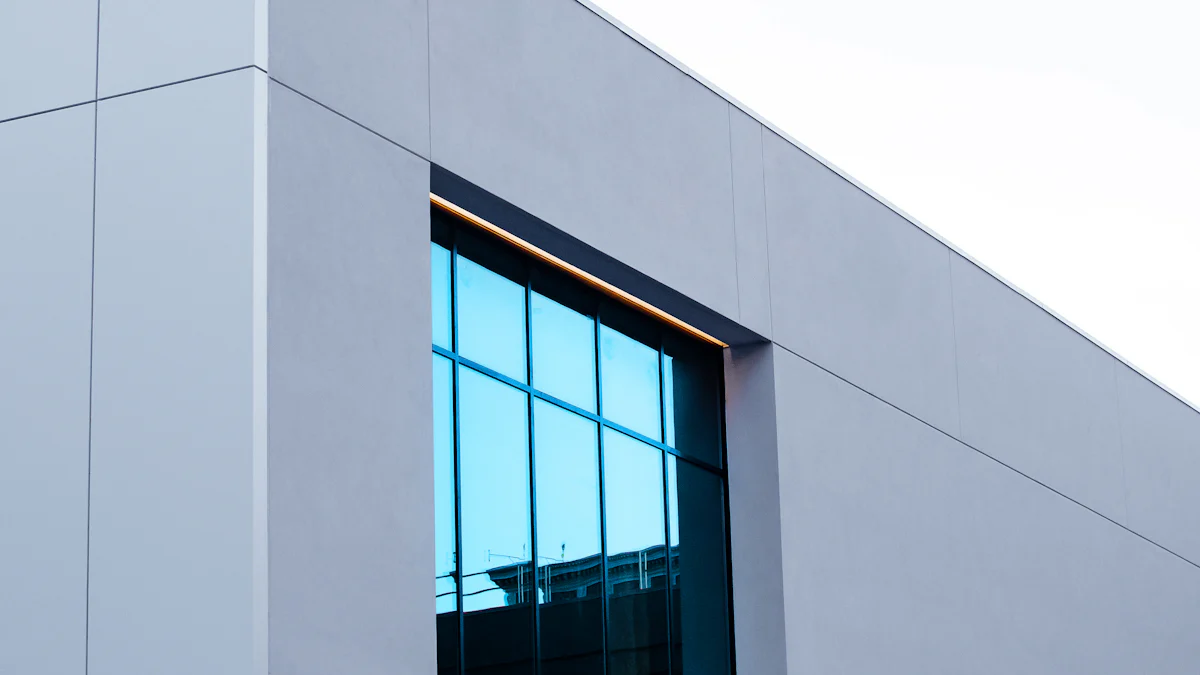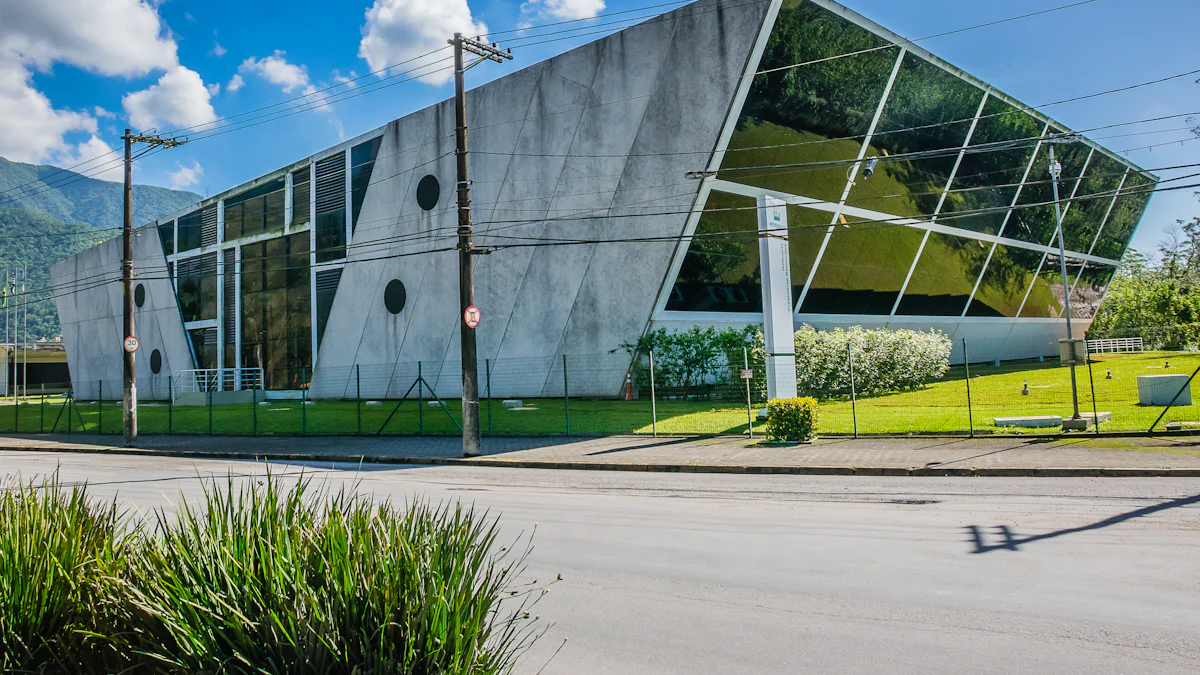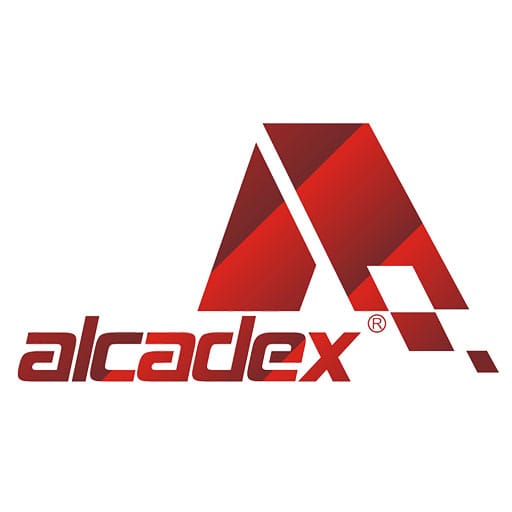
17 Feb Applications of Aluminum Composite Panels in Construction and Design
Table of Contents
- 1 Key Takeaways
- 2 What Are Aluminum Composite Panels?
- 3 Applications of Aluminum Composite Panels in Construction
- 4 Advantages of Aluminum Composite Panels
- 5 Innovative Uses of Aluminum Composite Panels in Modern Design
- 6 How to Choose the Right Aluminum Composite Panel
- 7
Aluminium composite panels have revolutionized modern construction and design. You can rely on this material for its unmatched durability, lightweight structure, and aesthetic flexibility. These aluminium composite panels combine aluminum layers with a core material, creating a product that is both strong and easy to handle. Architects and designers value them for their ability to merge style with functionality. The global market for aluminium composite panels reflects their growing demand, with projections reaching $9.8 billion by 2030. Their versatility makes them indispensable in both functional and decorative applications.
Key Takeaways
- Aluminum composite panels are lightweight yet durable, making them ideal for both structural and decorative applications in modern construction.
- These panels offer exceptional weather resistance and fire safety, ensuring long-term performance in various environmental conditions.
- With a wide range of finishes and colors, aluminum composite panels provide aesthetic versatility, allowing designers to achieve unique and striking architectural elements.
- Their low maintenance requirements save time and costs, making aluminum composite panels a practical choice for busy property owners.
- Incorporating aluminum composite panels can enhance energy efficiency in buildings, contributing to lower energy bills and a more sustainable environment.
- These panels are fully recyclable, supporting eco-friendly practices and helping projects achieve green building certifications.
- Aluminum composite panels are not just for buildings; they are also used in transportation and industrial applications, showcasing their versatility across different sectors.
What Are Aluminum Composite Panels?
Aluminum composite panels are a modern construction material that combines functionality with aesthetic appeal. These panels consist of two thin aluminum sheets bonded to a non-metal core, creating a lightweight yet durable structure. Their unique composition makes them a preferred choice for architects and designers seeking versatility and efficiency in their projects.
Composition of Aluminum Composite Panels
Core materials and aluminum layers
The core of an aluminum composite panel plays a crucial role in its performance. Typically, the core is made from non-metal materials such as mineral fillers or thermoplastic binders. This core is sandwiched between two aluminum sheets, which provide strength and stability. The combination of these materials ensures that the panels remain lightweight while offering excellent durability. This structure also allows the panels to be shaped, bent, or folded into various forms, making them suitable for diverse applications.
Protective coatings and finishes
To enhance their longevity and appearance, aluminum composite panels feature protective coatings and finishes. These coatings shield the panels from environmental factors like moisture, UV rays, and temperature fluctuations. You can find these panels in a wide range of finishes, including stone, wood, and metallic textures. Some even mimic natural materials, offering you the freedom to achieve specific design aesthetics without compromising on durability.
Key Properties of Aluminum Composite Panels
Lightweight and durable
Aluminum composite panels are known for their lightweight nature, which simplifies transportation and installation. Despite their light weight, they maintain exceptional strength, making them ideal for both structural and decorative purposes. This combination of lightness and durability reduces construction time and costs, providing you with a practical and efficient solution.
Weather resistance and fire safety
These panels are designed to withstand harsh weather conditions. They resist corrosion, moisture, and temperature changes, ensuring long-term performance. Many aluminum composite panels also meet fire safety standards, offering an added layer of protection for your projects. This makes ACP sheets a reliable choice for both residential and commercial buildings.
Aesthetic versatility with various finishes and colors
One of the standout features of aluminum composite panels is their aesthetic flexibility. Available in a variety of colors and finishes, they allow you to create visually striking designs. Whether you prefer a sleek metallic look or a natural wood texture, these panels can match your vision. Their ability to adapt to different styles makes them a favorite among designers aiming to achieve unique and modern architectural elements.
Applications of Aluminum Composite Panels in Construction

Exterior Applications
Facade cladding and building envelopes
Aluminum composite panels offer an excellent solution for facade cladding and building envelopes. Their lightweight structure simplifies installation, reducing labor costs and time. You can rely on their durability to withstand harsh weather conditions, including heavy rain, strong winds, and UV radiation. These panels also provide a sleek and modern aesthetic, making them a popular choice for contemporary architectural designs. Compared to traditional materials, aluminum composite panels deliver a cost-effective and long-lasting alternative without compromising on quality or appearance.
Roofing, canopies, and entrance systems
For roofing, canopies, and entrance systems, aluminum composite panels provide unmatched versatility. Their flexibility allows you to create unique shapes and designs that enhance the visual appeal of any structure. These panels resist corrosion and maintain their integrity even in extreme weather, ensuring long-term performance. Whether you are designing a commercial building or a residential property, aluminum composite panels offer a practical and stylish option for exterior features.
Restoration and rehabilitation projects
In restoration and rehabilitation projects, aluminum composite panels play a vital role. They are ideal for upgrading old structures, as their lightweight nature minimizes stress on existing frameworks. You can use these panels to restore facades, replace damaged cladding, or modernize outdated designs. Their wide range of finishes and colors allows you to match the original aesthetic or introduce a fresh, contemporary look. This makes aluminum composite panels a preferred choice for breathing new life into aging buildings.
Interior Applications
Wall panels, partitions, and false ceilings
Aluminum composite panels excel in interior applications such as wall panels, partitions, and false ceilings. Their lightweight design simplifies installation, while their durability ensures long-lasting performance. You can choose from various finishes and textures to create a polished and professional interior space. These panels also offer sound insulation and fire resistance, making them a practical choice for offices, retail spaces, and residential interiors.
Decorative details and wall dividers
For decorative details and wall dividers, aluminum composite panels provide endless possibilities. Their flexibility allows you to craft intricate designs that add character to any room. You can use these panels to create stylish accents, unique patterns, or functional dividers that enhance both aesthetics and functionality. The ACP panels low maintenance requirements make them a convenient option for busy environments.
Column coverings and interior accents
Aluminum composite panels are perfect for covering columns and adding interior accents. Their smooth finish and customizable designs help you transform structural elements into eye-catching features. You can select from a variety of colors and textures to complement your overall design theme. These panels also resist wear and tear, ensuring that your interior accents remain visually appealing over time.
Signage and Advertising
Outdoor signage and billboards
Aluminum composite panels are widely used for outdoor signage and billboards due to their durability and weather resistance. They maintain their appearance even under prolonged exposure to sunlight, rain, and wind. You can rely on their lightweight structure for easy installation and transportation. These panels also support vibrant printing, ensuring that your signage stands out and captures attention.
Point of purchase (POP) displays and exhibits
For point of purchase (POP) displays and exhibits, aluminum composite panels offer a versatile and cost-effective solution. Their smooth surface allows for high-quality graphics and branding, helping you create impactful displays. You can shape and customize these panels to fit various designs, making them ideal for trade shows, retail environments, and promotional events. Their durability ensures that your displays remain intact and visually appealing throughout their use.
Advantages of Aluminum Composite Panels
Durability and Longevity
Resistance to corrosion and weathering
Aluminum composite panels excel in durability, making them a reliable choice for long-term projects. These panels resist corrosion caused by moisture, pollutants, and UV radiation. You can trust them to maintain their structural integrity even in harsh environments. Their ability to withstand extreme weather conditions ensures that your investment remains protected over time. This resilience makes them ideal for both residential and commercial applications.
Low maintenance requirements
One of the standout benefits of aluminum composite panels is their low maintenance needs. Unlike traditional materials, these panels do not require frequent repairs or repainting. A simple cleaning routine keeps them looking pristine. This feature saves you time and reduces upkeep costs, making them a practical option for busy property owners. Their durability and minimal maintenance make them a cost-effective solution for modern construction.
Cost-Effectiveness
Affordable material and installation costs
Aluminum composite panels offer an economical alternative to traditional building materials. Their lightweight design reduces transportation and installation expenses. You can cut and shape them easily, which simplifies the construction process and lowers labor costs. Despite their affordability, these panels deliver exceptional performance and aesthetic appeal. This combination of quality and cost-efficiency makes them a preferred choice for budget-conscious projects.
Energy efficiency and insulation benefits
These panels contribute to energy-efficient building designs. Their core materials provide excellent insulation, helping to regulate indoor temperatures. So it is reduce your reliance on heating and cooling systems, leading to lower energy bills. By incorporating aluminum composite panels into your project, you can create a more sustainable and comfortable environment. Their energy-saving properties align with modern construction trends focused on efficiency and environmental responsibility.
Sustainability
Recyclable materials
Sustainability plays a crucial role in today’s construction industry, and aluminum composite panels meet this demand. These panels contain recycled aluminum and are fully recyclable at the end of their lifecycle. By choosing them, you support eco-friendly practices and reduce waste. Their recyclability ensures that they remain a sustainable option for years to come.
Contribution to green building certifications
Using aluminum composite panels can help you achieve green building certifications. Their energy efficiency, recyclability, and low environmental impact align with the criteria for sustainable construction. Incorporating these panels into your project demonstrates a commitment to environmentally responsible practices. This not only benefits the planet but also enhances the value and appeal of your property.
Innovative Uses of Aluminum Composite Panels in Modern Design

Creative Facade Designs
Unique patterns and textures
Aluminum composite panels have transformed the way architects approach facade designs. You can use these panels to create unique patterns and textures that elevate the visual appeal of any building. Their flexibility allows you to experiment with bold geometric shapes, intricate motifs, or even natural textures like wood and stone. These panels provide a modern aesthetic while maintaining durability, making them ideal for both residential and commercial projects. By incorporating aluminum composite panels, you can achieve a striking balance between functionality and artistic expression.
Integration with lighting and technology
Modern architecture often integrates lighting and technology into building exteriors. Aluminum composite panels support this trend by offering compatibility with LED lighting systems and smart technologies. You can design facades that light up at night, creating dynamic visual effects or highlighting specific architectural features. These panels also allow for seamless integration of sensors, screens, or other tech elements, enabling you to craft innovative and interactive designs. This combination of aesthetics and technology makes aluminum composite panels a forward-thinking choice for contemporary structures.
Custom Interior Design Solutions
Bespoke furniture and fixtures
Aluminum composite panels are not limited to walls and facades. You can use them to design bespoke furniture and fixtures that stand out in any interior space. Their lightweight nature makes them easy to handle, while their durability ensures long-lasting performance. Designers often craft cabinets, shelves, and tables using these panels, taking advantage of their wide range of finishes and colors. Whether you prefer a sleek metallic look or a textured wood finish, aluminum composite panels offer endless possibilities for creating custom furniture that combines style with practicality.
Artistic installations and accents
For artistic installations and interior accents, aluminum composite panels provide unmatched versatility. You can shape, bend, or cut these panels into intricate designs, allowing you to bring your creative vision to life. They work well for crafting decorative wall art, ceiling installations, or even room dividers with unique patterns. Their ability to mimic natural materials like marble or wood adds an extra layer of sophistication to your designs. By incorporating aluminum composite panels, you can transform ordinary spaces into visually captivating environments.
Applications Beyond Construction
Use in transportation and vehicle exteriors
The versatility of aluminum composite panels extends beyond buildings. You can find these panels used in the transportation industry for vehicle exteriors. Their lightweight structure reduces the overall weight of vehicles, improving fuel efficiency and performance. At the same time, their durability ensures resistance to weathering and wear, making them a reliable choice for buses, trains, and even airplanes. The panels also offer a sleek and modern appearance, enhancing the aesthetic appeal of transportation designs.
Industrial equipment and enclosures
Aluminum composite panels also play a significant role in industrial applications. You can use them to create enclosures for machinery, equipment, or electrical systems. Their strength and resistance to corrosion make them ideal for protecting sensitive components in harsh environments. Additionally, their smooth surface allows for easy cleaning and maintenance, ensuring long-term usability. By choosing aluminum composite panels for industrial purposes, you benefit from a material that combines practicality with durability.
How to Choose the Right Aluminum Composite Panel
Selecting the right aluminum composite panel for your project requires careful consideration. By understanding your needs and following best practices, you can ensure a successful outcome.
Factors to Consider
Project requirements and specifications
Start by evaluating the specific requirements of your project. Consider the purpose of the aluminum composite panel. Will it be used for exterior cladding, interior design, or signage? Each application may demand different properties, such as fire resistance, weather durability, or aesthetic finishes. Identify the environmental conditions the panels will face. For example, outdoor applications require panels with UV protection and corrosion resistance. Matching the panel’s features to your project ensures optimal performance and longevity.
Budget and cost considerations
Budget plays a crucial role in your decision-making process. Compare the costs of different panel types and finishes. While some panels may have a higher upfront cost, they could offer long-term savings through durability and low maintenance. Factor in installation expenses as well. Lightweight panels reduce labor costs and simplify handling. Balancing quality and affordability helps you achieve the best value for your investment.
Tips for Installation and Maintenance
Proper handling and installation techniques
Proper handling during installation is essential to maintain the integrity of aluminum composite panels. Use appropriate tools to cut and shape the panels without causing damage. Ensure the panels are stored flat to prevent warping. During installation, follow the manufacturer’s guidelines for fixing and sealing. Secure the panels firmly to avoid gaps or misalignment. A precise installation not only enhances the appearance but also ensures the panels perform effectively under various conditions.
Cleaning and upkeep for long-term performance
Regular cleaning keeps aluminum composite panels looking their best. Use a soft cloth or sponge with mild detergent to remove dirt and grime. Avoid abrasive materials that could scratch the surface. Rinse thoroughly with clean water to prevent residue buildup. For panels exposed to harsh environments, schedule periodic inspections to check for signs of wear or damage. Addressing minor issues promptly extends the lifespan of the panels and maintains their aesthetic appeal.
By considering these factors and following these tips, you can confidently choose and maintain aluminum composite panels that meet your project’s needs.
Aluminum composite panels have become an essential material in modern construction and design. You can rely on their lightweight structure, durability, and aesthetic flexibility to meet diverse project needs. Their applications range from facades to interior accents, offering a perfect balance of functionality and style. These panels also support sustainable practices with recyclable materials and energy-efficient properties. As technology advances, you will see even more innovative uses, ensuring aluminum composite panels remain at the forefront of architectural evolution.


